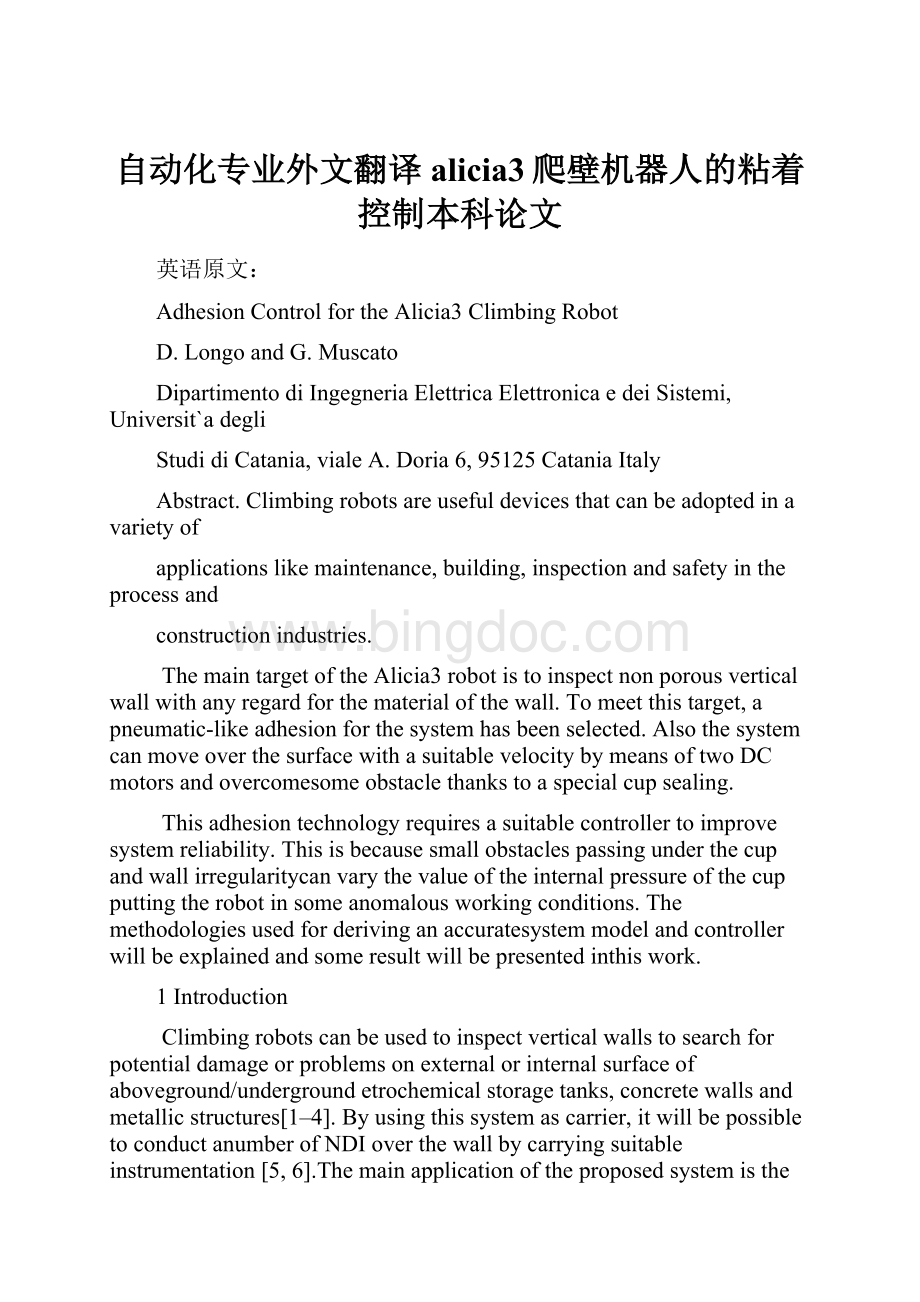自动化专业外文翻译alicia3爬壁机器人的粘着控制本科论文.docx
《自动化专业外文翻译alicia3爬壁机器人的粘着控制本科论文.docx》由会员分享,可在线阅读,更多相关《自动化专业外文翻译alicia3爬壁机器人的粘着控制本科论文.docx(15页珍藏版)》请在冰点文库上搜索。

自动化专业外文翻译alicia3爬壁机器人的粘着控制本科论文
英语原文:
AdhesionControlfortheAlicia3ClimbingRobot
D.LongoandG.Muscato
DipartimentodiIngegneriaElettricaElettronicaedeiSistemi,Universit`adegli
StudidiCatania,vialeA.Doria6,95125CataniaItaly
Abstract.Climbingrobotsareusefuldevicesthatcanbeadoptedinavarietyof
applicationslikemaintenance,building,inspectionandsafetyintheprocessand
constructionindustries.
ThemaintargetoftheAlicia3robotistoinspectnonporousverticalwallwithanyregardforthematerialofthewall.Tomeetthistarget,apneumatic-likeadhesionforthesystemhasbeenselected.AlsothesystemcanmoveoverthesurfacewithasuitablevelocitybymeansoftwoDCmotorsandovercomesomeobstaclethankstoaspecialcupsealing.
Thisadhesiontechnologyrequiresasuitablecontrollertoimprovesystemreliability.Thisisbecausesmallobstaclespassingunderthecupandwallirregularitycanvarythevalueoftheinternalpressureofthecupputtingtherobotinsomeanomalousworkingconditions.Themethodologiesusedforderivinganaccuratesystemmodelandcontrollerwillbeexplainedandsomeresultwillbepresentedinthiswork.
1Introduction
Climbingrobotscanbeusedtoinspectverticalwallstosearchforpotentialdamageorproblemsonexternalorinternalsurfaceofaboveground/undergroundetrochemicalstoragetanks,concretewallsandmetallicstructures[1–4].Byusingthissystemascarrier,itwillbepossibletoconductanumberofNDIoverthewallbycarryingsuitableinstrumentation[5,6].Themainapplicationoftheproposedsystemistheautomaticinspectionoftheexternalsurfaceofabovegroundpetrochemicalstoragetankswhereitisveryimportanttoperformperiodicinspections(rateofcorrosion,riskofairorwaterpollution)atdifferentrates,asstandardizedbytheAmericanPetroleumInstitute[7].Thesystemcanbealsoadoptedtoinspectconcretedams.
Whilethesekindsofinspectionsareimportanttopreventecological
disastersandrisksforthepeopleworkingaroundtheplant,thesearevery
expensivebecausescaffoldingisoftenrequiredandcanbeverydangerous
Fig.1.TypicaloperatingenvironmentandtheAlicia3robot
fortechniciansthathavetoperformtheseinspections.Moreover,forsafety
reasons,plantoperationsmustbestoppedandthetankmustbeemptied,
cleanedandventilatedwhenhumanoperatorsareconductinginspections.In
Fig.1(a)and1(b)typicalenvironmentsforclimbingrobotsareshown.Figure
1cshowstheAlicia3robotprototypewhileattachedtoaconcretewallduring
asystemtest.
2SystemDescription
TheAliciaIIsystem(thebasicmodulefortheAlicia3system)ismainly
composedbyacup,anaspirator,twoactuatedwheelsthatusetwoDCmotors
withencodersandgearboxesandfourpassivesteelballswithclearanceto
guaranteeplaincontactofthecuptothewall.Thecupcanslideoverawall
bymeansofaspecialsealingthatallowsmaintainingasuitablevacuuminside
thecupandatthesametimecreatingtherightamountoffrictionwithrespect
systemweightandarangeofatargetwallkind.
ThestructureoftheAliciaIImodule,showninFig.2,currentlycomprises
threeconcentricPVCringsheldtogetherbyanaluminumsdisc.Thebigger
ringandthealuminumsdischaveadiameterof30cm.Thesealingsystemis
allocatedinthefirsttwoexternalrings.Boththetworingsandthesealingare
Fig.2.StructureoftheAliciaIImodule
designedtobeeasilyreplaceable,astheywearoffwhiletherobotisrunning.
Moreoverthesealingallowstherobotpassingoversmallobstacles(about1cm
height)likescrewsorweldingtraces.Thethirdring(thesmallestone)isused
asabaseforacylinderinwhichacentrifugalairaspiratoranditselectrical
motoraremounted.Theaspiratorisusedtodepressurizethecupformedby
theringsandthesealing,sothewholerobotcanadheretothewalllikea
standardsuctioncup.
Themotor/aspiratorsetisveryrobustandiscapableofworkinginharsh
environments.Thetotalweightofthemoduleis4Kg.
TheAlicia3robotismadewiththethreemoduleslinkedtogetherbymeans
oftworodsandaspecialrotationaljoint.Byusingtwopneumaticpistonsitis
possibletoriseandtolowereachmoduletoovercomeobstacles.Eachmodule
canberaised15cmwithrespecttothewall,soobstaclesthatare10–12cm
height,canbeeasilyovercame.Thesystemisdesignedtobeabletostay
attachedusingonlytwocupswhilethethird,anyofthethree,israisedup.
Thetotalweightofthesystemisabout20Kg.
3Electro-PneumaticSystemModel
Byusingthiskindofmovementandsealingmethod,itispossible,dueto
unexpectedsmallobstaclesonthesurface,tohavesomeairleakageinthe
cup.Thisleakagecancausetheinternalnegativepressuretoriseupandin
thissituationtherobotcouldfalldown.Ontheothersideiftheinternal
pressureistoolow(highΔp),averybignormalforceisappliedtothe
system.Asaconsequence,thefrictioncanincreaseinsuchawaytonot
allowrobotmovements.Thisproblemcanbesolvedbyintroducingacontrol
looptoregulatethepressureinsidethechambertoasuitablevaluetosustain
thesystem.Theconsideredopenloopsystemandthemosteasilyaccessible
systemvariableshasbeenschematizedinFig.3;inthisschemethefirstblock
includestheelectricalandthemechanicalsubsystemandthesecondblock
includesthepneumaticsubsystem.TheusedvariablesaretheMotorvoltage
reference(theinputsignalthatfixesthemotorpower)andtheVacuumlevel
(thenegativepressureinsidethechamber).
Fig.3.Theopenloopsystemconsidered
Fig.4.I/Ovariableacquisitionscheme
Sinceitisverydifficulttohaveareliableanalyticalmodelofthatsystem,
becauseofthebignumberofparametersinvolved,ithasbeendecidedto
identifyablackboxdynamicmodelofthesystembyusinginput/output
measurements.Thismodelwasdesignedwithtwopurposes:
tocomputea
suitablecontrolstrategyandtoimplementasimulatorfortuningthecontrol
parameters.
Anexperimentalsetupwasrealized,asrepresentedinFig.4,byusing
theDS1102DSPboardfromDspaceinordertogenerateandacquirethe
input/outputvariables.SincetheaspiratorisactuatedbyanACmotor,a
powerinterfacehasbeenrealizedinordertotranslateinpowerthereference
signalforthemotorcomingfromaDACchanneloftheDS1102board.The
outputsystemvariablehasbeenmeasuredwithapiezoresistivepressure
sensorwithasuitableelectronicconditioningblockandacquiredwithone
analoginputoftheDS1102.ThesoftwarerunningontheDSpaceDSPboard,
inthisfirstphasesimplygeneratesanexcitingmotorvoltagereferencesignal
(pseudorandom,ramporstepsignals)andacquiresthetwoanaloginputs
withasamplingtimeof0.1s,storingthedatainitsinternalSRAM.
TypicalInput/OutputmeasurementsarerepresentedinFig.5andFig.6.
Inordertoobtainbetterresultsinsystemmodeling,therelationshipbetween
InputandOutputneedstobeconsideredasnon-linear.ANARXmodelhas
beenusedisintheformof
(1),wherefisanonlinearfunction[8,9].
y(k)=f(u(k),u(k−1),...;y(k−1),y(k−2),...)
(1)
Toimplementthiskindofnon-linearity,sometrialshavebeendoneusing
Neuro-FuzzyandArtificialNeuralNetwork(ANN)methodologies.Oncethat
modelhasbeentrainedtoasuitablemeansquareerror,ithasbeensimulated
givingitasinputtherealinputmeasurementonly(infinitesteppredictor)[8].
So
(1)canbemodifiedinordertoobtain
(2).
˜y(k)=f(u(k),u(k−1),...;˜y(k−1),˜y(k−2),...)
(2)
In
(2),4yistheestimatedsystemoutput.Inordertocomparethesimulation
results,anumberofdescriptorhasbeendefinedandused.Amongtheseare
meanerror,quadraticmeanerrorandsomecorrelationindexes.Afirstset
ofsimulationforbothmethodologieshasbeendonetofindoutthebestI/O
regressiontermschoice.
3.1Neuro-FuzzyIdentification
Usingthiskindofmethodology,thebestmodelstructurewasfoundtobein
theformof(3).
y(t)=f(u(t),y(t−1))(3)
Oncethebestmodelstructurehasbeenfound,sometrialshavebeen
performedmodifyingthenumberofmembershipfunctions.Thebestresults,
comparingtheindexesdescribedabove,havebeenobtainedwith3functions
andinFig.7thesimulationresultshasbeenreported.Thestructureofthe
Neuro-FuzzymodelistheANFIS-Sugeno[10].
3.2ANNIdentification
Usingthiskindofmethodology,thebestmodelstructurewasfoundtobein
theformof(4).
y(t)=f(u(t),u(t−1),u(t−2),y(t−1),y(t−2))(4)
Asinglelayerperceptronnetworkhasbeenused.Thetrainingalgorithm
isthestandardLevenberg–Marquardt.
Oncethebestmodelstructurehasbeenfound,sometrialshavebeenperformed
modifyingthenumberofhiddenneurons.Thebestresults,comparing
theindexesdescribedabove,havebeenobtainedwith7hiddenneuronsand
inFig.8thesimulationresultshasbeenreported.
Fromacomparisonbetweenthetwomodelsandtheirrelatedindexes,it
canbeseenthattheNeuro-Fuzzymodelhasbestapproximationperformance
anduselessinputinformation.Inthenextsection,thismodelwillbeusedas
systememulatortotuneandtesttherequiredregulator.
4PressureControlAlgorithm
Onceasystemmodelhasbeenobtained,aclosedloopconfigurationlikethat
inFig.9,hasbeenconsidered.
Thetargetofthecontrolalgorithmistoregulatetheinternalvacuumlevel
toasuitablevalue(fromsometrials,itwasfixedtoabout10kPa)tosustain
thewholesystemanditspayload;themaximumsteadystateerrorallowed
wasfixed